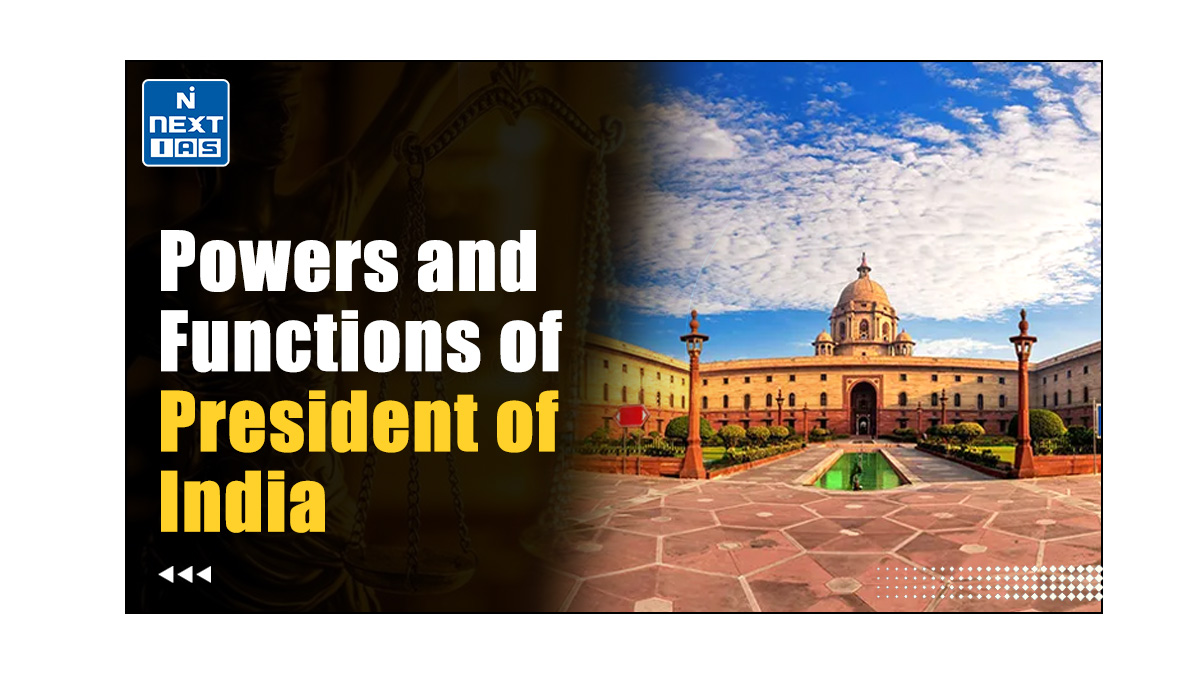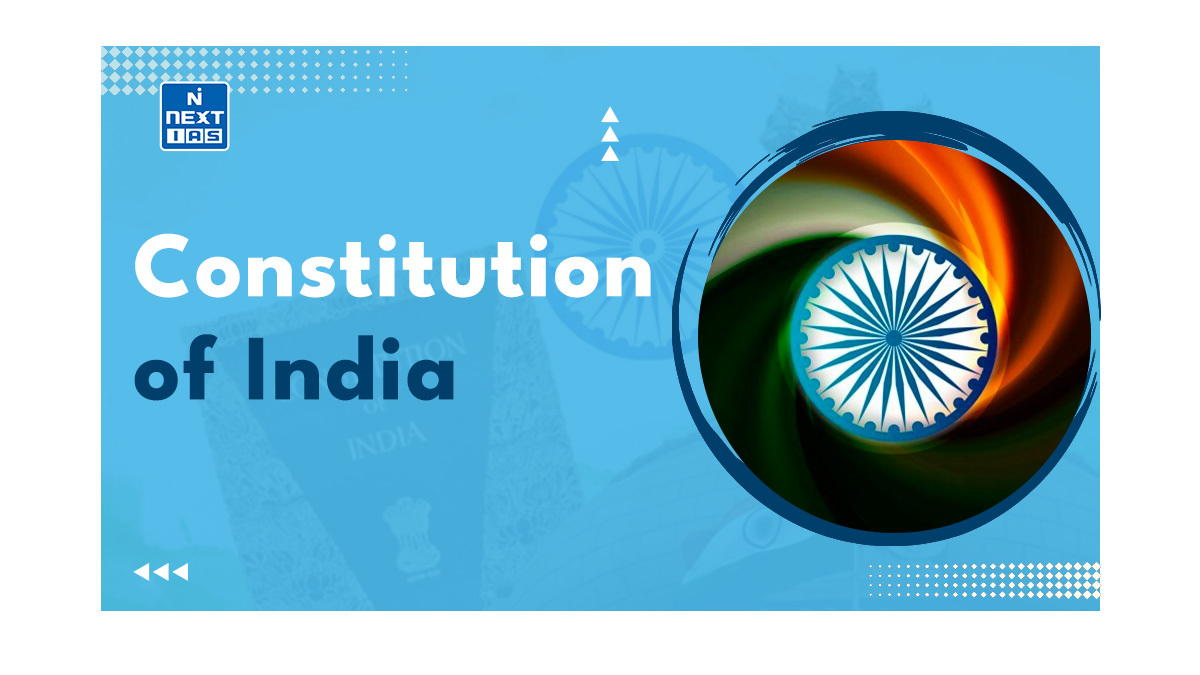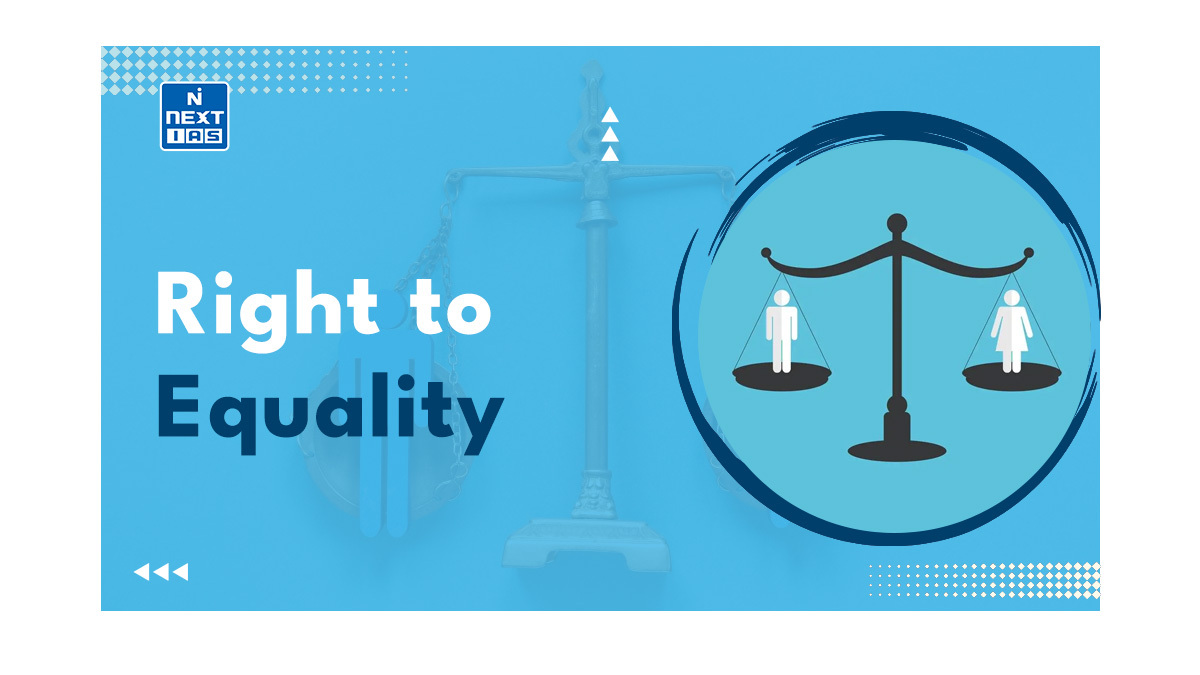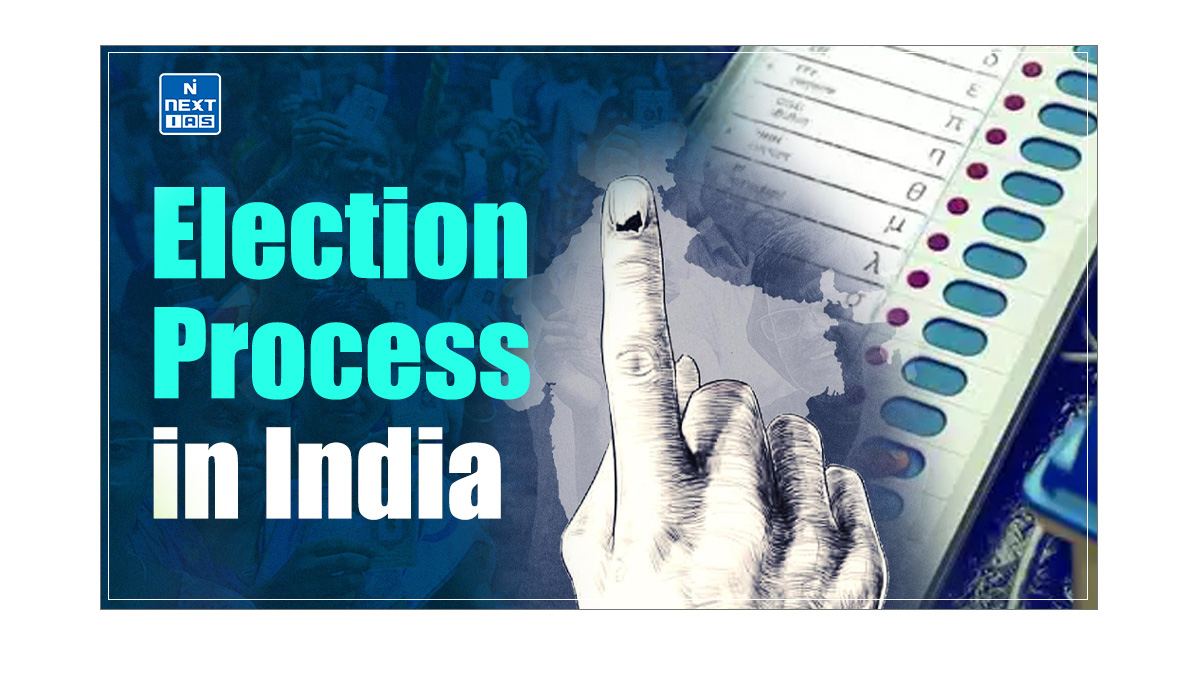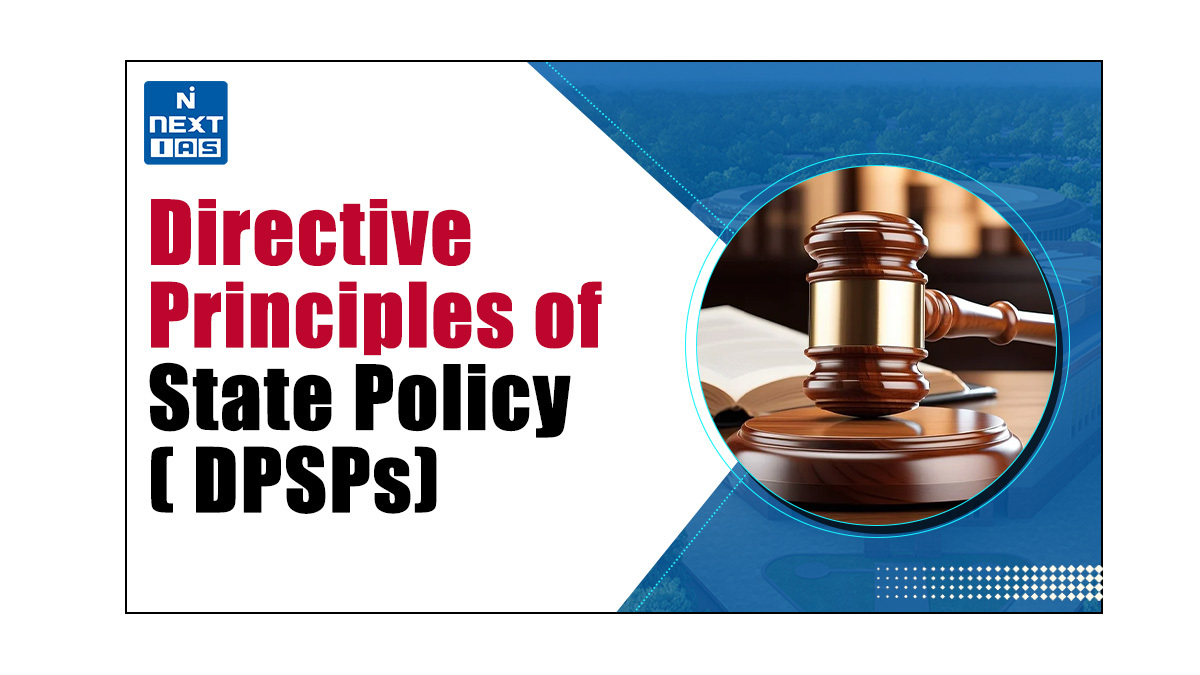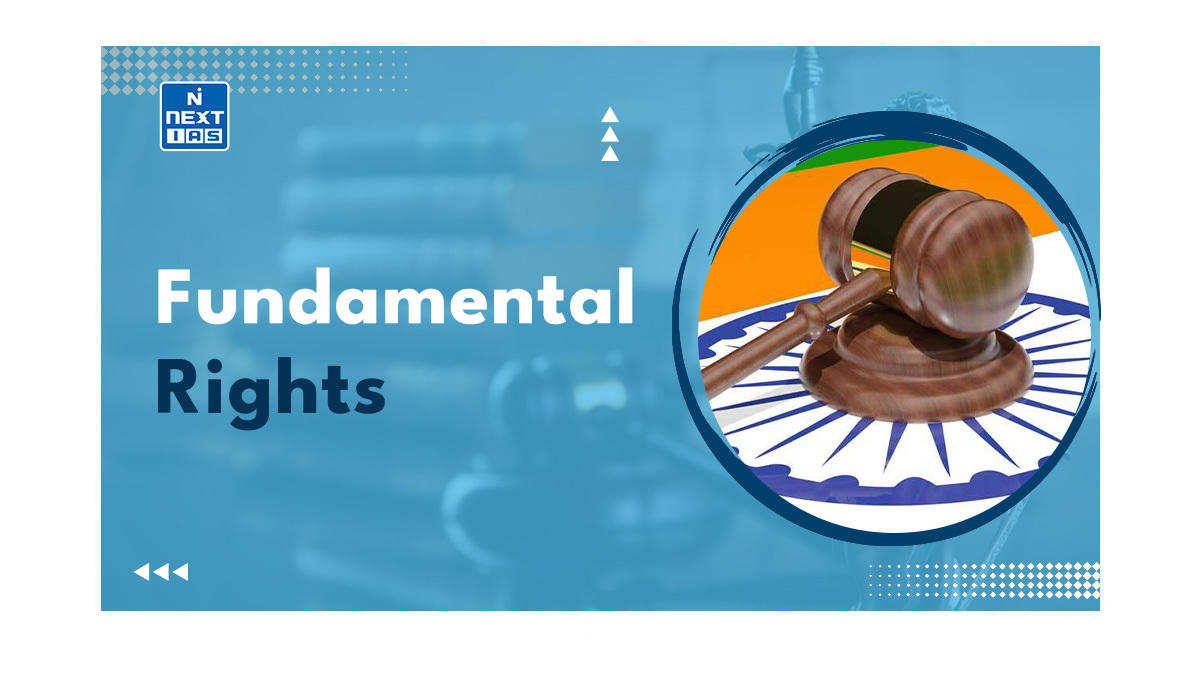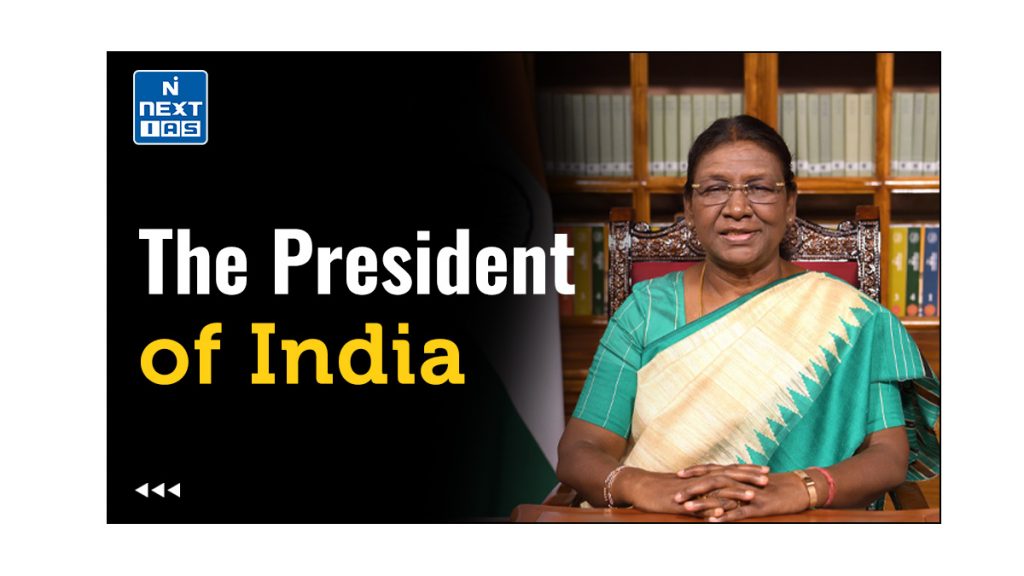
The office of the President of India has been envisaged by the Constitution of India as the constitutional head of the Indian State. Despite being only a nominal head of the Executive, the President of India plays a significant role in Indian polity through his/her diverse executive, legislative, and judicial powers. This article of NEXT IAS aims to study in detail the President of India, related constitutional provisions, process of elections and impeachment, conditions of office, functions, powers, and other related aspects.
About President of India
- The President of India is the highest office of the land under the constitutional framework of India.
- The office of the President of India has been envisaged as:
- The head of the Indian State,
- The first citizen of India,
- The Titular or nominal or de jure head of the Union Executive, and
- The Commander-in-Chief of the Indian Armed Forces.
| The Union Executive consists of: – The President of India, – The Vice-President of India, – The Prime Minister of India, – The Council of Ministers (CoM), and – The Attorney General of India (AGI) |
Constitutional Provisions Related to President of India
- Articles 52-78 in Part V of the Indian Constitution deal with the Union Executive of India. They also contain some key provisions related to the President of India.
- The constitutional provisions mentioned under these articles deal with matters related to the election, qualifications, impeachment, powers & functions, and other aspects related to the office of the President of India.
Election of President of India
The President of India is elected not directly by the people of India, but by the members of a electoral college as described below.
| Electoral College |
| Members who vote in the Presidential Election | Members who do not vote in the Presidential Election |
| The elected members of both Houses of Parliament | The nominated members of both Houses of Parliament |
| The elected members of Legislative Assemblies of States | The nominated members of State Legislative Assemblies |
| The elected members of Legislative Assemblies of Union Territories of Delhi and Puducherry | Both elected and nominated members of State Legislative Councils |
| The nominated members of Legislative Assemblies of Union Territories of Delhi and Puducherry |
- Where an Assembly is dissolved, members cease to be qualified to vote in the Presidential election, even if fresh elections to the dissolved assembly are not held before the Presidential election.
- To achieve uniformity in the scale of representation of different states as well as parity between States as a whole and the Center, the number of votes each member of the Electoral College is entitled to cast is determined in the following manner:
- Value of Vote of a Member of Legislative Assembly (MLA) = Total population of State/Total number of elected members in State Legislative Assembly) x 1/1000
- Value of Vote of a Member of Parliament (MP) = Total values of votes of all MLAs of all States/Total number of elected MPs
- In order to win the election, a presidential candidate must secure a fixed quota of votes as defined as follows:
- Electoral Quota = [(Total number of valid votes polled/2)+1]
- The Presidential election is held in accordance with the System of Proportional Representation by means of the single transferable vote.
- The voting is done by secret ballot.
| Reasons for choosing the method of indirect election for the President – The President is only a nominal executive, with the real powers vested in the Council of Ministers headed by the Prime Minister. It would have been anomalous to have the President elected directly by the people and not give him any real power. – The direct election of the President would have been very costly and time-consuming. This was unwarranted for getting elected a person which is only a symbolic head. |
Provisions Related to Disputes Regarding Election of President
- All doubts and disputes in connection with the election of the President are inquired into and decided by the Supreme Court whose decision is final.
- The election of a person as President cannot be challenged on the ground that the electoral college was incomplete i.e. existence of any vacancy among the members of the electoral college.
- If the election of a person as the President is declared void by the Supreme Court, acts done by him before the date of such declaration are not invalidated and continue to remain in force.
Qualifications of President of India
A person to be eligible for election as the President of India should possess the following qualifications.
- He/she should be a citizen of India.
- He/she should have completed 35 years of age.
- He/she should be qualified for election as a member of the Lok Sabha.
- He/she should not hold any office of profit under the Union government, any State government, any local authority, or any other public authority.
- Note: A sitting President or Vice-President, Governor, and Minister of Union/State is not deemed to hold any office of profit.
Further, a presidential candidate has to fulfill the following conditions for his/her election as the President of India:
- His/her nomination for election to the office of President must be subscribed by at least 50 electors as proposers and 50 electors as seconders.
- He/she has to make a security deposit of ₹ 15,000 in the Reserve Bank of India.
- Note: The security deposit so made is liable to be forfeited in case the candidate fails to secure 1/6th of the votes polled.
Oaths and Affirmations by President of India
- The oath of office of the President is administered by the Chief Justice of India, and in his/her absence, the senior-most judge of the Supreme Court.
- In his/her oath, the President swears:
- To faithfully execute the office,
- To preserve, protect, and defend the Constitution and the law,
- To devote himself to the service and well-being of the people of India.
Conditions of the President’s Office
The conditions of the office of the President of India as laid down by the Constitution are as follows:
- He/she should not be a member of either House of Parliament or the House of State Legislature.
- If any such person is elected as President, he is deemed to have vacated his seat in that house on the date on which he/she enters upon his/her office as President.
- He/she should not hold any other office of profit.
Entitlement of President of India
While serving in the office, the President of India is entitled to:
- Use the official residence of the President of India, the Rashtrapati Bhavan, without payment of any rent.
- Receive such emoluments, allowances, and privileges as may be determined by Parliament.
| – The emoluments and allowances of the President of India cannot be diminished during his/her term of office. – The Current Salary of the President of India is ₹ 5 lakhs per month. |
Immunities available to the President of India
The President of India is entitled to a number of privileges and immunities as described below:
- He/she enjoys personal immunity from legal liability for his/her official acts.
- During his/her term of office, he/she is immune from any criminal proceedings, even in respect of his/her personal acts.
- Civil proceedings can be instituted against him/her in respect of his/her personal acts during his/her term of office after giving two months’ notice.
- While serving in the office, he/she cannot be arrested or imprisoned.
Term of President’s Office
- The President holds office for a term of 5 years from the date on which he/she enters his/her office.
- He can hold office beyond his term of 5 years until his/her successor assumes charge of that office.
- He is eligible for re-election to that office for any number of terms.
Resignation of President of India
The President of India can resign by addressing the resignation letter to the Vice-President of India.
Impeachment of President of India
- The President of India can be removed from office before the completion of his/her term by a well-defined process, known as the impeachment Process.
- The process of impeachment of the President of India is a quasi-judicial procedure in the Parliament.
Grounds for Impeachment of President of India
The sole ground for the impeachment of the President is – ‘Violation of the Constitution’. However, it is to be noted that the phrase ‘Violation of the Constitution’ has not been defined in the Constitution.
Process of Impeachment of President of India
The chronological order of the process of impeachment of the President of India can be seen as follows:
- The impeachment charges can be initiated by either House of the Parliament, i.e. Lok Sabha or Rajya Sabha.
- These charges should be signed by 1/4th members of the House that frames the charges and a 14-days’ notice should be given to the President of India.
- After the impeachment resolution is passed by a majority of 2/3rd of the total membership of that House, it is sent to the other House, which should investigate the charges.
- The President has the right to appear and to be represented in such an investigation.
- If the other House also sustains the charges and passes the impeachment resolution by a majority of 2/3rd of the total membership of that House, then the President stands impeached/removed from his office from the date on which the resolution is so passed.
The following points need to be noted regarding the impeachment process of the President:
- The nominated members of either House of Parliament can participate in impeachment, though they do not participate in his election.
- The elected members of Legislative Assemblies of States and Union Territories of Delhi and Puducherry do not participate in impeachment, though they participate in his election.
| Note: No President of India has been impeached so far. |
Vacancy in President’s Office
- A vacancy in the President’s Office can occur in the following ways:
- On the expiry of his/her tenure of 5 years
- On his/her removal by the impeachment process
- By his/her resignation
- By his/her death
- Otherwise, i.e. when he/she becomes disqualified to hold office or when his/her election is declared void.
- When a vacancy is caused by the expiration of the term of the sitting President, an election to fill such vacancy must be held before the expiration of the term, i.e. 5 years.
- In case of any delay in conducting the due election, the outgoing President continues to hold office beyond his term of 5 years, until his successor assumes charge.
- This is provided by the Constitution to prevent an interregnum.
- In this case, the Vice-President does not get the opportunity to act or discharge the functions of the President.
- In case of any delay in conducting the due election, the outgoing President continues to hold office beyond his term of 5 years, until his successor assumes charge.
- When a vacancy is caused by resignation, removal, death of the President, or otherwise, the Vice-President acts as the President until a new President is elected.
- An election to fill such a vacancy should be held within 6 months.
- The newly elected President remains in office for a full term of 5 years from the date he/she assumes charge.
- When the sitting President is unable to discharge his/her functions due to absence, illness, etc, the Vice-President discharges his functions until the President resumes his/her office.
| Note: 1. In all the above cases, in case the office of Vice-President is vacant, the Chief Justice of India (CJI) would fulfil the duties of the President, or if the office of the CJI is also vacant, then the senior-most judge of the Supreme Court available acts as the President of India. 2. When any person, i.e. the Vice President, the Chief Justice of India, or the senior most judge of a Supreme Court is acting as the President, he/she enjoys all the powers and immunities of a President and is entitled to such emoluments, allowances, and privileges as determined by the Parliament of India. |
Functions and Powers of President of India
The powers and functions of the President of India can be studied under the following heads:
Read our detailed article on Functions and Powers of President of India.
Constitutional Position of President of India
- The Constitution of India provides for a Parliamentary form of government. Consequently, the President has been made only a nominal Executive, with the real Executive being the Union Council of Ministers (CoM).
- Accordingly, Article 74 provides that there shall be a CoM to aid and advise the President who shall, in the exercise of his functions, act in accordance with such advice. Thus, a major part of the powers of the President is only nominal.
- However, the President also possesses some situational discretion (as discussed in the section below) which makes him important in Indian polity.
Discretionary Powers of President of India
Though the President of India has not been provided with constitutional discretions, he/she has some situational discretion in the following circumstances:
- Appointment of the Prime Minister of India when no party has a clear majority in the Lok Sabha or when the Prime Minister in office dies suddenly and there is no obvious successor.
- Dismissal of the Union Council of Ministers (CoM) when it fails to prove a majority in the Lok Sabha.
- Dissolution of the Lok Sabha when the Council of Ministers (CoM) has lost its majority in the Lok Sabha.
Conclusion
The President of India, as the highest constitutional authority of the nation, occupies a pivotal position in the democratic framework of the country. Despite being only a nominal head of the Executive, the President of India plays a significant role in Indian polity. Through his diverse functions, he ensures the smooth functioning of and coordination among the 3 wings of the Union government.
Important Articles Related to the President of India
| Article No. | Subject Matter |
|---|---|
| Article 52 | The President of India |
| Article 53 | Executive Power of the Union |
| Article 54 | Election of President |
| Article 58 | Qualifications for Election as President |
| Article 60 | Oath or Affirmation by the President |
| Article 61 | Procedure for impeachment of the President |
| Article 62 | Time of holding election to fill the vacancy in the office of President |
| Article 65 | Vice-President to act as President or to discharge his functions |
| Article 71 | Matters relating to the election of President. |
| Article 72 | Power of the President to grant pardons etc. and to suspend, remit, or commute sentences in certain cases |
| Article 74 | Council of Ministers to aid and advise the President |
| Article 85 | Sessions of Parliament, Prorogation, and Dissolution |
| Article 111 | Assent to bills passed by the Parliament |
| Article 112 | Union Budget (Annual Financial Statement) |
| Article 123 | Power of the President to promulgate the ordinances |
| Article 143 | Power of the President to consult the Supreme Court |
Frequently Asked Questions (FAQs)
Is the President Constitutional head of the State?
The constitutional head of the Executive of the Union is the President.
Who was the first President of India?
The first President of India was Dr. Rajendra Prasad.
What is the position of the President in India?
The President of India is the ceremonial head of state and the supreme commander of the armed forces, holding a pivotal role in the Indian political system.
What are the privileges of the President?
The President enjoys several privileges, including immunity from legal prosecution, protection from arrest or detention, and the right to address Parliament. Additionally, the President can grant pardons, reprieves, respites, and commute sentences in certain cases.
Who can participate in the impeachment of the President?
The impeachment of the President can be initiated by either house of Parliament, with a written motion signed by at least one-fourth of the members of the house. The motion must then be passed by a two-thirds majority in both houses, after which the President may be removed from office.
